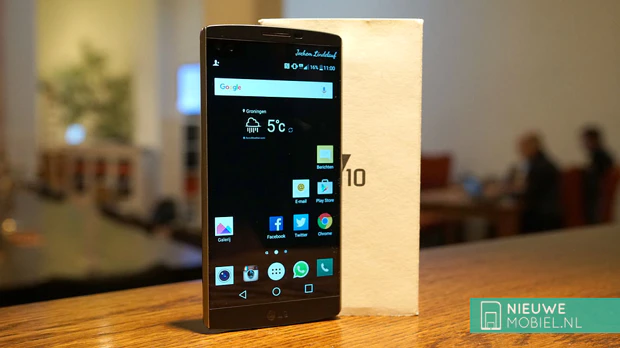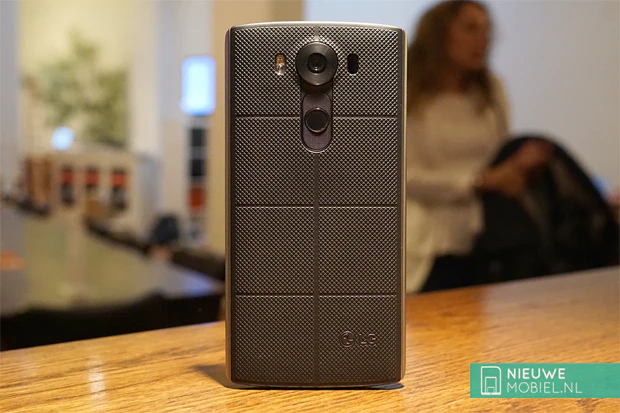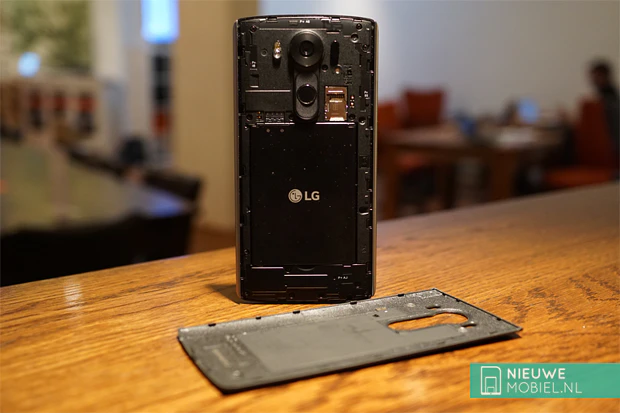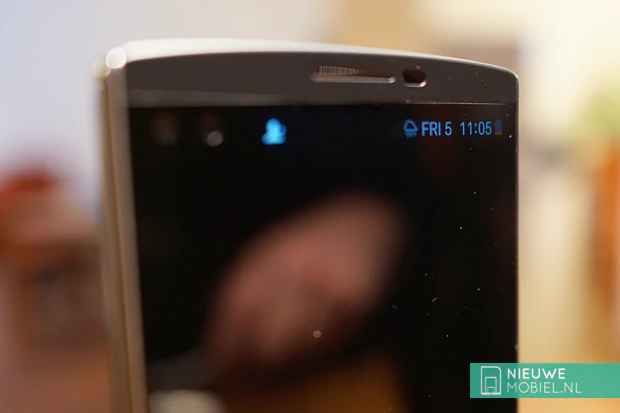LG V10 review
Raw husk, white wick
LG wants to position a new series of smartphones alongside its successful G Series. The first version is this remarkable LG V10.

This V-series will not be characterized by the latest hardware. Instead, additional techniques will be built in. For example, the V10 has a double self-image camera and a second screen. Furthermore, a 5.7-inch Quad HD IPS screen and fingerprint scanner are also available. With this, the V10 has to gain a place among the other high-end phablets on the market.
Content of the box
MicroUSB data cable
Adapter
Quad Beat 3 headphones
So LG puts its money on two flagships and because the G5 is not yet available at the time of writing, it is next to the V10 for the time being the G4. This one has a slightly smaller screen but has the same processor, camera and battery and is now a lot cheaper. The special features of the V10 must be very special to make up for this. Another Android device with a 5.7 inch screen with extra functionality is the Samsung Galaxy S6 edge+. There is also fierce competition from other big guys like the Nexus 6P, the iPhone 6s Plus and the Microsoft Lumia 950 XL.
Design
The V10 is built around a stainless steel frame. This should make the aircraft extra strong and therefore LG claims that it meets a standard of the U.S. Army. Incidentally, this standard is not inspected by an independent party for consumer electronics, so it may have to be taken with a grain of salt. Nevertheless, the V10 absolutely feels as if it can take a beating. Although this does not mean that it is also water resistant.

At the front of the V10 a glass plate covers the two screens and the double self-image camera. Both above and below there is a matte plastic part. On top we find the ear loudspeaker and a couple of sensors. Beneath the screen there is a little more space with the LG-logo in it. On top the V10 has an infrared transmitter and at the bottom we find the headset and microUSB connections plus a speaker.

As with LG's G Series units, the V10's physical buttons are located on the back. This allows the sides of the unit to consist of two solid metal edges that are nicely rounded. The on/off button is round because it also functions as a fingerprint scanner. Above the buttons, the camera protrudes slightly with a wide metal edge around it. The back of the camera is covered by a removable plastic cover. This is wrapped in a ribbed rubber coating called LG 'Dura Skin'.

Because of the metal sides and rubber back the V10 feels very robust. Its weight adds to that, because with 192 grams it is not a light boy. The back also provides the necessary grip you don't get from the metal sides. Because an extra screen is placed above the 5.7 inch screen, the V10 is also quite large. With such devices, you always have to look for a way to hold it comfortably. This goes pretty well, but you will have to maneuver a lot.
Performance
The V10 has a replaceable battery with a capacity of 3,000 mAh. That's about the lower limit for devices with a 5.7 inch screen. With a screen-on-time of four to five hours, we found it difficult to fill the 24 hours. It will survive a long working day, but with this the V10 joins the range of smartphones that will have to be recharged every night.



".
Because the V10 does not yet run on Android 6.0, it does not yet have the power saving function 'Doze'. So you have to do it with the regular power saving mode that can automatically turn on at 15 or 5 percent remaining battery level. Apps can be limited and the second screen can be turned off. There's also a game optimizer that adjusts video quality in games to save battery power.


The V10 already has 64 GB of storage memory as standard, but a microSD card up to 200 GB can also be placed next to the SIM card.
Screen
The V10's screen has a resolution of 2560 × 1440 pixels, giving a pixel density of 515 PPI. The screen also features the IPS Quantum technique. On the G4 we were already talking about this and also this time it proves its power. Especially contrast reproduction is a strong point. The brightness can also be nice and low. Although the image may be a bit bluish, this does not bother you. By the way, more pixels does not mean that more of the interface is visible on the screen. Everything is mainly shown larger and more detailed. Especially the Play Store is rather inflated. Changing the font size can improve this a bit.

The second screen measures 2.1 inches diagonally and has a resolution of 160 × 1040 pixels. It appears to form a whole with the main screen but functions completely separately from it. You can read more about its functionality in this review.


Software
Unfortunately the V10 still comes with Android 5.1.1. Now there is not something wrong with Android 5.x but the interface of LG can use a refresher and we are very curious how they are going to do that. Android 6.0 has also brought some improvements. Like the earlier mentioned 'Doze' but also a new permissions policy for apps. Permissions no longer need to be approved all at once before downloading the app, but the approval only needs to be done when an app asks for it.



".
Now the interface still largely corresponds to the LG G4. For the virtual function keys at the bottom of the screen, you can choose between a white and black background or transparent for the start screen. The number of touch keys at the bottom of the screen can be expanded to up to five with keys for notification, Dual Window, QuickMemo+ and QSlide. QSlide is the name of the option to reduce or open most LG apps as a kind of floating widget, but with full functionality. This allows a different kind of multitasking.



".
A 5x5 grid is available on the home screens to place shortcuts and widgets. To the left of the normal start screens is Google Now for pure Android, HTC Blinkfeed and LG places 'Smart Bulletin' here. This is a list of small cards for quick access to the calendar, LG Health, music, smart tips, QuickRemote, smart settings, music and Evernote. We didn't really think it had much added value. The screen can be turned off in its healed state but replaced by Google Now is not possible. To expand the number of start screens you need to zoom out by pinching on an existing start screen.



By dragging the notification bar down, the notification screen appears with switches at the top for things like WiFi, Vibrate mode, Screen rotation and NFC. You can scroll through it horizontally and unused switches can be turned off. Beneath this line of fairly large switches is a slider for screen brightness and one for ringtone volume. These can also be turned off. When the QSlide and/or Quick Remote are also switched on, the messages are pushed even further down.



".
In the application menu, apps can also be placed in folders and you can choose from two formats for the icons. Apps can be sorted by alphabet, download date or in their own format. LG still maintains a separate tab for widgets. This is a rather useless functionality and gives the menu a somewhat outdated look.
Hardware
The V10 is the first LG device to have a fingerprint scanner. The scanner looks a bit smaller than we saw at the 'Nexus'. As a result, you have to place your finger a little more precisely and sometimes several attempts are necessary. The scanner cannot activate and unlock the device at once. You first have to turn on the screen by pressing the button. This is a bit more difficult to do because of the placement on the back than with a button on the side. You have to hold the device firmly to reposition it after unlocking it so that you can operate the touchscreen. You can also activate the screen by tapping it twice and then unlock it with a PIN code or Knock Code tapping pattern. Especially useful when the device is on the table and the scanner is more difficult to reach.



".
With the main screen off, the second screen acts as a status bar showing the weather, date, time and battery level. There is also room for notifications. After a swipe from right to left vibration mode, WiFi, flashlight and camera can be activated. When the main screen is switched on, notifications are also displayed on the second screen. In addition, it has six other possible functions. For example, the five most recently used apps can be displayed, controls for the music player, calendar appointments and shortcuts for five apps and five contacts. Finally, you can also show a signature in the form of a self-entered word or phrase. Switching between the different functions is done by swiping across the second screen.


Although Android takes very good care of displaying notifications, it can sometimes be nice to get them on a second screen. For example, when you are watching a movie in full screen or something like that. Unfortunately, this function on the V10 works rather erratically. Sometimes notifications are indeed only shown on the second screen, other times on both screens and sometimes as usual on the main screen. This seems to be especially different between apps from LG itself and third parties such as WhatsApp. Being able to quickly switch between your last used apps is handy, but because the main screen is so large, you have to reach very far to the second screen and the ease of use is partly nullified. It would be more convenient and logical to use a second screen in combination with a smaller main screen.



".
LG has been building an infrared transmitter into its devices for some time now. It can be used with the QuickRemote app on the V10 as a remote control for supported devices. Such as TVs, set-top boxes, audio devices, air conditioners and projectors. Convenient and since Samsung decided to take this function out of the Galaxy S7 (edge) it is definitely distinctive.



".
The V10 also has support for HiFi DAC audio. For this you only need to connect an audio device or headset. LG delivers an AKG-tuned white in-ear headset with copper colored accents with the V10. Sound indeed sounds a little fuller and your music files should support it as well. The speaker on the bottom is not really impressive.
Camera
The 16 megapixel camera is the same type as in the G4. With an aperture of f/1.8 it lets more light through and has an infrared color spectrum sensor which makes it possible to capture colors even more realistically. There is also optical image stabilization and laser autofocus.


The software of the camera has been slightly modified. Switching between the different camera modes can be done via the second screen. By default, the camera is in automatic mode and the interface looks the same as on the LG G4. With this, both photos and videos can be taken and you can adjust flash and mode. Between the modes are also slow motion and timelapse. Strangely enough we don't find these in the manual video mode. In the settings, HDR, aspect ratio and video quality, cheese shutter, self-timer, raster, optical image stabilization can be adjusted and/or enabled. For video, image stabilization is not available in UHD-quality.


Although the camera already delivers very nice images in this auto mode, a fully manual mode can also be used for both photo and video. In this mode, the LG V10 is quite unique. With both you can set white balance, focus point, brightness, ISO and shutter speed. Photos can be shot in RAW. For video, frame rate and bit rate can be adjusted and it is adjustable whether sound on the front or back of the camera needs to be recorded louder. Even in the highest frame rate of 60 FPS, image stabilization is not available.


The camera works very fast and also the operation of the various functions in the manual modes is easy and smooth. The camera hardly does anything wrong. Colors and details come into their own with little noise. The extra image stabilization is also a fine function during filming. It is a pity at best that HDR is a bit hidden away in the menu, because this can improve a photo even further on a regular basis. In the manual modes you have even more room to use your own preferences and creativity and get the most out of the camera. Exposure and focus can be set well.
The two self-image cameras both have a size of five megapixels and they cannot be used side by side. Instead, you can switch between the two to take selfies with an angle of 80 or 120 degrees. This allows you to get two different effects; wide angle and portrait. Preferably we would have seen that both cameras were used to get one 'super' photo. Now you have to choose in advance.
Conclusion
The V10 feels very solid physically and in terms of computing power. Its endurance is slightly less robust, but it is not so bad that it will get in the way. Moreover, the battery can easily be replaced. With the excellent 5.7 inch screen, the V10 overall is a very solid performing phablet.
The question remains whether the additional features are really distinctive and add something. As far as we are concerned, this is hardly the case for the double self-image camera. LG could also have chosen just the camera with the larger angle. The second screen has the potential to add something, but actually the V10 is too big to use it comfortably. A lot of functionality is also a bit double up with what Android does by itself. Apps, contacts and notifications are quickly available on Android. Moreover, notifications are not consistently displayed on the second screen.
That leaves the camera. Its functionality does stand out. This was already a strong point on the G4 and with the improved software it performs even better on the V10. The V10 actually made us curious about the G5.

